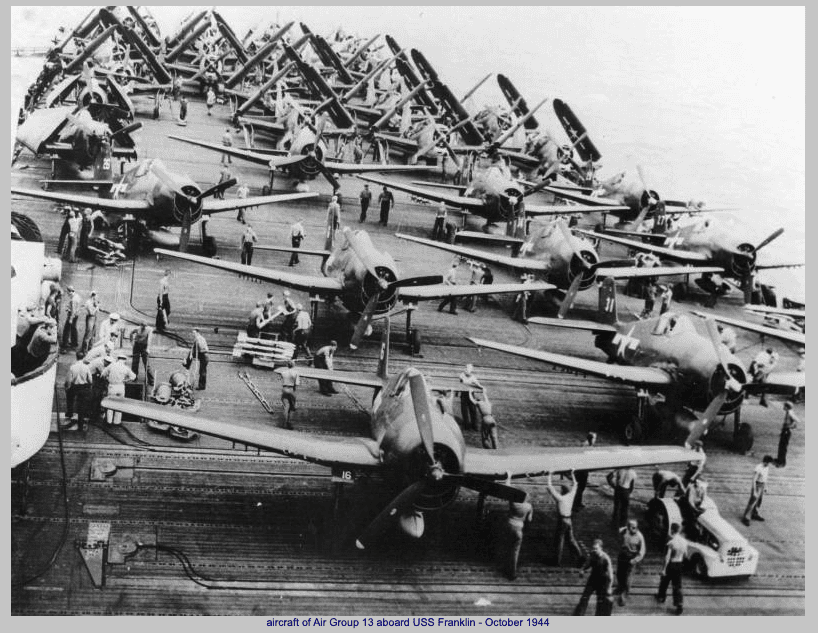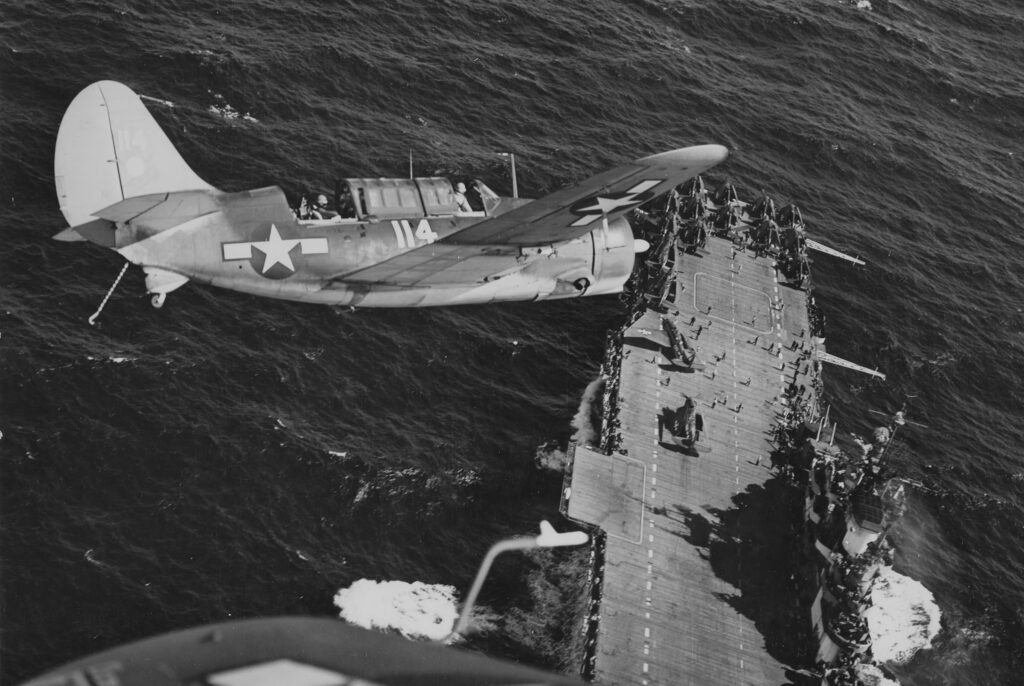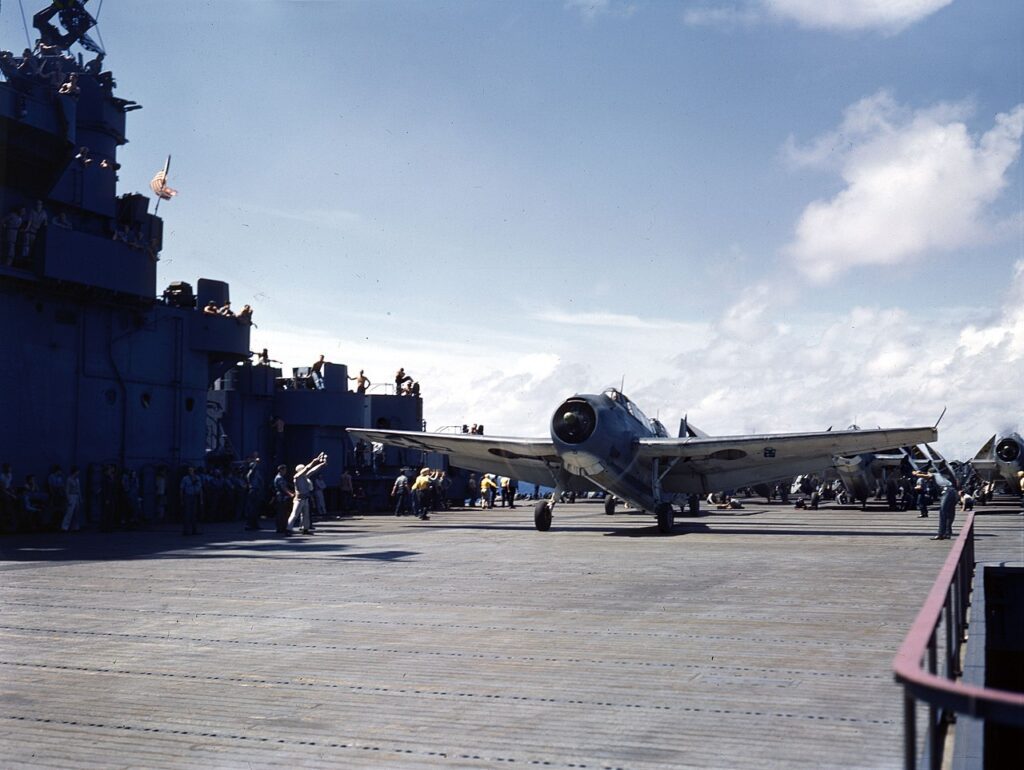USS Franklin Aircraft: Corsairs, Helldivers, And More! (Part 1 of 2)

As a boy, long before I heard of USS Franklin, I was fascinated by World War II military aircraft. In the beginning, my attention was fixed on B-17s, P-47s, and P-51s. As my interest turned to the Pacific Theater of Operations, I came to admire the P-40s flown by the Flying Tigers and the US Army Air Force, as well as P-38s. I then turned to naval aviation where I learned of Wildcats, Devastators, and PBYs. Then I learned about Hellcats, Helldivers, and my favorite, the F4U Corsair.
The personnel aboard a US Navy carrier are divided between the ship’s company and the air wing, also known as the air group. The ship’s company is responsible for operating the ship, sailing it, and maintaining it. The air wing, whose sailors are commonly called “airedales,” arms, maintains, and flies the aircraft flying off of her.
The events of 19 March 1945 impacted both the ship’s crew and Air Group 5 of USS Franklin. Because Captain Gehres ordered the air group off the carrier, most of my research has been focused on the crew. But the little boy in me kept bugging adult me wanting to know more about the airplanes that flew off of her. Since the entire reason for a carrier’s existence is to use its aircraft to attack the enemy, I needed to learn more anyway. This is part 1 of a two-part series discussing the aircraft that called Big Ben home.
The mix of aircraft aboard Franklin and other carriers changed as the US Navy responded to the evolving Japanese strategy. Big Ben served two tours of duty in the Pacific, the first from July to the end of October 1944; the second measuring less than two weeks in March 1945. Even though she was out of the war for a few months, when she returned, the US Navy had dramatically altered the composition of aircraft aboard carriers in the Pacific Theater (PTO).
US Navy Strategy In 1944
In July 1944, US Navy fleet airpower was focused on maintaining control of the seas by
- Forcing a decisive battle with the Imperial Japanese Navy (IJN) if it presented itself
- Protecting Allied shipping from attacks by the IJN naval, surface, or submarine forces
- Attacking enemy land bases
- And providing close air support to our forces during amphibious landings.
To do this, Essex-clas carriers such as Franklin, carried a mix of bombers, torpedo planes, and fighters. Each carrier’s aircraft was organized into an “Air Group.” In 1944, the air group’s identifying number was the same as that of its home carrier. Since USS Franklin was designated as CV-13, its air group became Air Group 13. Leaving for the Pacific, Franklin carried 96 aircraft.
USS Franklin Aircraft During 1944 Tour
Air Group 13, commanded by Cmdr. Charles C. Howerton, was further divided into squadrons by type or mission role. 1 Each squadron was identified by two letters followed by a number. For example, In 1944, the fighter squadron assigned to Franklin was known as VF-13. The letter “V” signified a squadron composed of heavier-than-air craft (as opposed to lighter-than-air craft such as blimps and dirigibles). The letter “F” signified a fighter squadron followed by a number. Therefore, VF-13 was composed of heavier-than-air craft that were fighters assigned to Franklin, which was CV-13.
World Class Fighters: (VF-13) “Fighting 13”

The fighter role was filled by VF-13 commanded by Commander William M. Coleman. Thirty-six Grumman F6F-3 Hellcats made up the squadron. Their roles were to provide
- Protection for the bombers and torpedo planes when on the attack against the enemy
- Protection for the fleet and their aircraft carrier (fighters were considered a carrier’s first line of defense)
- Close Air Support for ground troops
- And strafing and bombing of ground targets
There were also four Hellcats configured as night fighters and two configured for photo reconnaissance. 2 Note that, at this point, fighters represented just over a third of the aircraft on a typical carrier.
The Hellcat replaced its smaller cousin, the Wildcat, in 1943. Armed with six .50 caliber machine guns, it could also reach 376 mph at 22,000 feet altitude. While not as fast as the Corsair, its fine design and its frontline service for two and a half years enabled it to destroy more Japanese aircraft than any other fighter in the US inventory.3
Precision Bombers: “Bombing 13” (VB-13)

Commander Richard Kibbe commanded 36 SB2C Helldivers in VB-13.4 The Helldiver, nicknamed “The Beast” by her crews, was the successor to the venerable SBD Dauntless Dive Bomber. It was the first US Navy dive bomber to have internal storage in the fuselage for bombs, torpedoes, or depth charges. Crewed by a pilot and a rear gunner, it could also mount bombs, rockets, and other small weapons in underwing mounts. It could carry up to 2,000 pounds of armaments at a time. Slower than fighters, its maximum speed was 295 mph at 16, 700 feet.5
An anonymous member of Kibbe’s squadron penned The History of Bombing Squadron 13. In it, he writes of the early days of the squadron:
Things went along smoothly enough, and November 1, 1943 marked the arrival of Rear Admiral C.T. Durgin, who commissioned the Squardron and made it officially the newest dive bombing squadron in Uncle’s fightin (sic) Navy. By this time Lt. Comdr. R. L. Kibbe was made chief whip-cracker of the group. Mr. Kibbe realized that all work and no play makes Jack a sloppy wingman, so he started the ball rolling by treating the boys to the first in a series of bang-up parties. The fellows had lots of fun in New Jersey, although the good citizens of New York and Philadelphia must have thought that a new Indian frontier had been discovered downn in the Cape May Area, even tho (sic) Wildwood in mid-winter would make Grant’s tomb seem like Coney Island in July.
But it was not all roses. We worked and worked hard, simulating bombing and gunnery attacks on anything that made a likely target. One tragedy occurred. Ensign Mathew J. Miller, a Chicago Boy, and Hiatt H. Cowen, crashed into the sea and were killed on 8 Dec. 1943, while making a practice bombing run.6
Lethal Torpedoes: “Torpedo 13” (VT-13)

Lt. Commander Larry French, a veteran of the Battle of Midway, commanded VT-13 composed of 18 TBF-1C Avengers. The Avenger was the US Navy’s torpedo bomber for nearly all of World War II. It had a maximum speed of 271 mph at 12,000 feet altitude and a combat range of 1215 miles. A pilot, bombardier, and rear gunner composed the crew.7
Rise of the Kamikazes

From July to October 1944, Franklin flew sortie after sortie against Iwo Jima and her sister islands, Guam, Yap, Ulithi, and other islands earning three battle stars. In October, she was a part of Task Force 38 commanded by Admiral William Halsey, and took part in supporting the Invasion of the Philippines. At that point in the war, the Japanese military was facing severe shortages of men and materiel. IJN Captain Eiichiro Jyo, commanding the light carrier Chiyoda, suggested that Admiral Ozawa immediately organize special attack squadrons to carry out “crash-dive” tactics against the US fleet. Admiral Ozawa rejected the idea. But soon thereafter Admiral Takijiro Onishi, who was about to take command of land-based air assets in the Philippines, began developing plans for these squadrons.8 The admiral supported the use of kamikaze squadrons because he believed it would take eight bombers escorted by 16 fighters to sink one carrier while one to three kamikazes could accomplish the same goal.9
While Admiral Onishi launched the first organized kamikaze attack on 25 October 1944, there were earlier attempts, perhaps due to individual initiative or a pilot knowing he couldn’t make it back to his base and wanting to do as much damage as possible.
Franklin was the victim of one such attack. Late in the afternoon of 13 October 1944, five Japanese medium bombers (called “Bettys” by the US Navy) attacked the task group to which Franklin belonged. The anti-aircraft fire of the destroyers and cruisers in the group’s defensive screen turned away the first. The others were taken under fire by Franklin and other ships. The first plane was hit and began burning. Although damaged, it released a torpedo which passed under the fantail. The pilot then attempted to crash Franklin. It struck, then slid across the flight deck just abaft of the Island, exploding as it struck the water on the starboard side.10 AMM 1st Class Harold Stancil, assisting an F6F Hellcat which had just landed, ran, as did others including Landing Signal Officer Lt. Dan Winters. Lt. Winters was brushed by the plane’s left wingtip as he dove for cover, which tore out the seat of his pants. When he stood up and ran to the edge of the deck to see what was left of the bomber, his pants fell down exposing his rear end.
He was otherwise unhurt, but tragically, Stancil was struck by the plane, or a piece of it, becoming the first crewmember to die in combat on Franklin. He would be buried at sea later that night.11
Twelve days later, on 25 October, escort carriers USS Santee (CVE-29) and USS Suwanee (CVE-27) were struck and damaged by kamikazes during the Battle off Samar. USS St. Lo (CVE-63), also an escort carrier, was the first major warship to be sunk by a kamikaze. 12 Other ships were either slightly damaged or successfully shot down kamikazes.
On 30 October, it was Franklin’s turn again. The task group of which Big Ben was a part, was attacked by six bombers, three kamikazes targeting Franklin. The first barely missed, crashing into the sea 20 feet off the port side. At 1426, the second carrying a 550-pound general-purpose bomb pierced the flight deck creating a 12X35 foot hole. The bomb detonated on the hangar deck igniting raging fires among the planes on the flight and hangar decks. The USS Franklin CV-13 War Damage Report stated:
Blasts and fragments ruptured aircraft fuel tanks which caused the fires to spread rapidly and to increase in intensity. Fires also were started by blast, burning gasoline, and gasoline vapor explosions which penetrated to various compartments below the hangar deck level. On the flight deck the fire quickly spread to the other planes in the vicinity of the after elevator and engulfed 5-inch mounts Nos. 5 and 7.13
Fifty-six men would die and 60 would be wounded in the conflagration following the attack. A third kamikaze bomber flew over Big Ben and dropped a 1,000-pound bomb which narrowly missed her. Under fire from Franklin and other ships, the bomber struck USS Belleau Wood (CVL-24) a light carrier. There 92 men were killed or missing in action and 54 were wounded.14 (The picture above shows Franklin and Belleau Wood burning.)
Franklin returns to the mainland
After putting out the fires and honoring her dead, Big Ben returned, first to Ulithi, then to Pearl Harbor. It was decided that her damages were too much for the dockyards at Pearl, so she was sent to Bremerton, Washington. The History of USS Franklin (CV-13) states:
Upon arrival, Air Group 13 left the ship. Since their first combat operation on Franklin, this air group had destroyed or damaged at least 338 enemy planes, sunk 60 merchant ships for a total of 155,000 tons, damaged another 66 enemy merchantmen, sunk 15 enemy warships totaling 57,950 tons, and had damaged 19 others totaling 254,500 tons. They had flown 3,971 combat sorties against the enemy.15
Part 2 Here: USS Franklin Fields More Fighters (Part 2 of 2)
Did you arrive here via a search engine? I am the author of the forthcoming book, Heroes By The Hundreds: The Story of the USS Franklin (CV-13). In addition to writing about the bravery of the crews that saved her, I will be writing about the lessons we can learn in leadership and crisis management. I’ll also write about the changes the US Navy made as a result of those lessons learned.
I send out a monthly newsletter, Glenn’s After-Action Report, writing about subjects I find interesting in my research. You can sign up for it below. Feel free to leave a comment or ask a question. Thanks for reading.-Glenn
Footnotes
- Steve Jackson, Lucky Lady: The World War II heroics of the USS Santa Fe and Franklin (New York: Carroll and Graf, 2004) 130
- Joseph A. Springer, Inferno: The Epic Life and Death Struggle of the USS Franklin in World War II, (Minneapolis, MN, Zenith Press, 2011) 38
- Walter A. Musciano, Warbirds of the Sea: A History of Aircraft Carriers & Carrier-based Aircraft (Atglen, PA: Schiffer, 1994) 259-61
- Springer 48
- Walter A. Musciano, 217-218
- USS Franklin CV-13 Original Documents 1943-1946 (Paducah, KY: Turner Publishing Co. 1994) 43
- Walter Musciano 182-183
- Rod MacDonald, Task Force 58 The US Navy’s Fast Carrier Strike Force that Won the War in the Pacific (Annapolis: Naval Institute Press) 2021 355
- Clark G. Reynolds, The Fast Carriers: The Forging of an Air Navy (Annapolis: Naval Institute Press, 2013) 331
- USS Franklin CV-13 War Damage Report 10
- Lucky Lady 181-82,189
- Samuel Eliot Morison, History of United States Naval Operations in World War II vol. XII (Edison, NJ: Castle Books, 2001) 300-02
- The USS Franklin CV-13 War Damage Report 13-14
- Morison Vol XII 342
- Original Documents, The History of USS Franklin (CV-13) 88
1 Comments
Leave a Comment
You must be logged in to post a comment.
[…] (Read part 1: USS Franklin Aircraft: Corsairs, Helldivers, And More!) […]